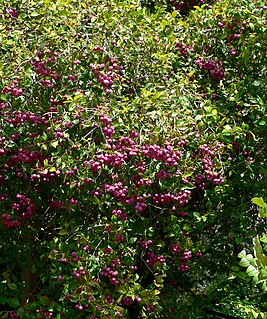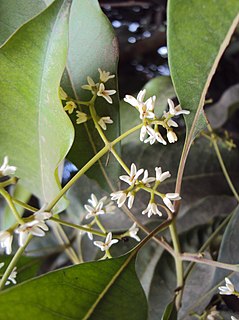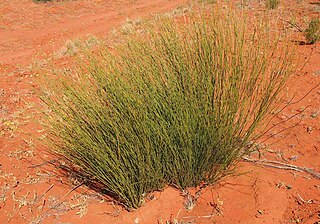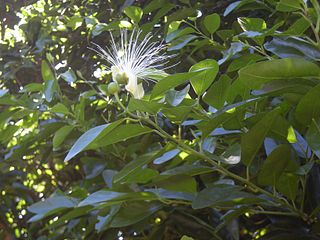
Syzygium smithii is a summer-flowering, winter-fruiting evergreen tree, belonging to the myrtle family Myrtaceae. It shares the common name "lilly pilly" with several other plants. In New Zealand, it is commonly known as 'monkey apple'. It is planted as shrubs or hedgerows, and features: rough, woody bark; cream and green smooth, waxy leaves; flushes of pink new growth; and white to maroon edible berries. Unpruned, it will grow about 3–5 m (9.8–16.4 ft) tall in the garden.
The cherry is the fruit of many plants of the genus Prunus. The plants themselves are also called cherries, and the wood they produce is called cherry.

Syzygium paniculatum, the magenta lilly pilly or magenta cherry, is a species of flowering plant in the myrtle family Myrtaceae, native to New South Wales, Australia. A broad dense bushy rainforest tree, in cultivation it grows to a height of 15 m (49 ft) with a trunk diameter up to 35 cm (14 in). The largest known example is at Ourimbah Creek, 35 m (115 ft) metres tall. The leaves are 3–9 cm (1.2–3.5 in) long, opposite, simple and slightly obovate, tapering at the leaf base. They are dark glossy green above, and paler below. White flowers are produced in clusters. The edible fruit is usually magenta, but can be white, pink or purple.

Exocarpos is a genus of flowering shrubs and small trees in the sandalwood family, Santalaceae. They are found throughout Southeast Asia, Australia and the Pacific Islands.

Exocarpos cupressiformis, with common names that include native cherry, cherry ballart, and cypress cherry, belongs to the sandalwood family of plants. It is a species endemic to Australia. Occasionally the genus name is spelt "Exocarpus" but it appears to be mostly no longer in use.

Syzygium luehmannii is a medium-sized coastal rainforest tree native to Australia. Common names include riberry, small leaved lilly pilly, cherry satinash, cherry alder, or clove lilli pilli.

Lophostemon confertus, is an evergreen tree native to Australia, though it is cultivated in the United States and elsewhere. Common names include brush box, Queensland box, Brisbane box, pink box, box scrub, and vinegartree. Its natural range in Australia is north-east New South Wales and coastal Queensland but it is commonly used as a street tree in Sydney, Melbourne, Perth and other cities in eastern Australia.

Chionanthus ramiflorus, commonly known as northern olive or native olive, is a species of shrubs and trees, of the flowering plant family Oleaceae. They grow naturally in India, Nepal, northeastern Australia (Queensland), New Guinea, the Philippines, southern China and Taiwan.

Exocarpos sparteus is an Australian endemic plant species, commonly known as the broom ballart, slender cherry, or native cherry. The species is found in all states of mainland Australia.

Syzygium australe, with many common names that include brush cherry, scrub cherry, creek lilly-pilly, creek satinash, and watergum, is a rainforest tree native to eastern Australia. It can attain a height of up to 35 m with a trunk diameter of 60 cm. In cultivation, this species is usually a small to medium-sized tree with a maximum height of only 18m.

Eustrephus is a monotypic genus in the family Asparagaceae, subfamily Lomandroideae.
Buchanania obovata is a small to medium-sized understorey tree in woodlands native to northern Australia, in particular in Arnhem Land in the Northern Territory. Common names include green plum and wild mango.

Buchanania arborescens, commonly known as little gooseberry tree or sparrow's mango, is a small and slender tree native to seasonal tropical forests of northern Australia, south-east Asia, and the Solomon Islands.

Melaleuca viridiflora, commonly known as broad-leaved paperbark is a plant in the myrtle family, Myrtaceae and is native to woodlands, swamps and streams of monsoonal areas of northern Australia and New Guinea. It is usually a small tree with an open canopy, papery bark and spikes of cream, yellow, green or red flowers.

Cryptocarya triplinervis is a rainforest tree growing in eastern Australia. Common names include the three veined laurel, three veined cryptocarya and the brown laurel.

Flindersia collina, commonly known as broad-leaved leopard tree, leopard ash, bastard crow's ash or leatherwood, is a species of tree in the family Rutaceae and is endemic to north-eastern Australia. It usually has pinnate leaves with between three and seven elliptical to spatula-shaped leaves, panicles of white flowers and fruit studded with rough points.

Capparis arborea is a bush or small tree occurring in eastern Australia. The habitat is rainforest; usually riverine, littoral or the drier rainforests. Distributed from the Hunter River, New South Wales to Cape Melville in tropical Queensland. Common names include native pomegranate, wild lime, wild lemon and brush caper berry.

Acalypha eremorum is a species of shrubs of the plant family Euphorbiaceae, endemic to Queensland, Australia. Commonly known as soft acalypha, turkey bush or native acalypha. The species grows as an open branched shrub to 2 m tall with small leaves with crenate margins. Plants may shed their leaves in response to prolonged drought. Branches often end in spines, especially on smaller plants. Small flowers are produced in spikes throughout the year and are followed by deeply lobed capsular fruit.

Ehretia saligna, commonly known as peach bush, native willow and peachwood is a species of shrubs or small trees, endemic to Northern Australia. The natural range extends from the Gascoyne, across the Northern Territory throughout northern Queensland and coastal; regions of Southern Queensland and New South Wales.

Clematicissus opaca, called small-leaf grape, pepper vine, small-leaved water vine, yaloone and wappo wappo, is a small vine endemic to Australia. Pepper vine is naturally found in rocky locales in monsoon forest, littoral rainforest and open forest, and is occasionally grown as a garden plant. The plant is primarily restricted to coastal and sub-coastal regions in Queensland and New South Wales, although it does occur inland, west of the Great Dividing Range, in central New South Wales,




















